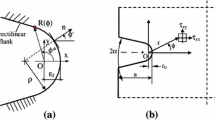Abstract
The states of stress and strain at the root of V and U-notches were examined through the use of an elastic-plastic finite element computer program in an effort to develop a criterion for predicting the site of crack initiation. Using simple bending under conditions approximating plane stress, the sites of initiation were determined experimentally to be well removed from the notch centerline. Furthermore, the paths of crack propagation followed the directions of pure shear strain,i.e. the “characteristic” directions. The slip line fields,i.e. the directions of pure shear strain, produced from the results of the finite element program agreed well with results expected from classical plasticity solutions. Examinations of numerous stress and strain quantities along and between the slip lines were conducted in an effort to evolve a selectivity rule that could be used to predict along which slip line a velocity discontinuity would be activated to form a crack. A rapid decrease in the average value of pure shear strain along the contour of the notch near the initiation site provided the sought predictive capability.
Similar content being viewed by others
References
J. W. Spretnak:Proc. 1st Int. Conf. on Structural Mechanics in Nuclear Reactor Technology, p. 615, Berlin, September, 1972.
J. W. Spretnak:Mining and Metallurgy Quarterly, Division of Mining, and Metallurgy of the School of Natural Sciences and Technology of Ljubliana, Jogoslavia, vol. 22, p. 51, English translation available from U.S. Department of Commerce, NTIS, Springfield, Virginia.
A. K. Chakrabarti and J. W. Spretnak:Met. Trans. A, 1975, vol. 6A, pp. 733–36, A. K. Chakrabarti and J. W. Spretnak:Met. Trans. A, 1975, vol. 6A, pp. 737–47.
D. Hauser: Ph.D. Dissertation, Ohio State University, Columbus, Ohio, 1973.
J. W. Spretnak:Trans. Jap. Inst. Metals, 1968, vol. 9, pp. 306–12.
A. K. Chakrabarti: Ph.D. Dissertation, Ohio State University, Columbus, Ohio, 1973.
C. A. Griffis and J. W. Spretnak:Trans. Iron Steel Inst. Jap., 1969, vol. 9, pp. 372–87.
R. Hill:The Mathematical Theory of Plasticity, p. 149, Oxford at the Clarendon Press, 1956.
J. W. Spretnak: “Limitations to Useful Ductility in Forming Processes,”Proc. 7th International Conf. on Forging, Nr. XXI, Brussels, Sept., 1971.
F. K. Th. Van Iterson:Plasticity in Engineering, pp. 113–20, Hafner Publishing Co., Inc., New York, N.Y., 1947.
M. Salmon, L. Berke, and R. Sandhu. Report No. AFFDL-TR-68-39, Flight Dynamics Laboratory, Wright-Patterson Air Force Base, Ohio, May, 1970.
V. J. Russo: Ph.D. Dissertation, Ohio State University, Columbus, Ohio, 1974.
Author information
Authors and Affiliations
Additional information
This paper is portion of a dissertation submitted by V. J. Russo in partial fulfillment of the requirements for Ph.D. degree, Ohio State University.
Rights and permissions
About this article
Cite this article
Russo, V.J., Chakrabarti, A.K. & Spretnak, J.W. The role of pure shear strain on the site of crack initiation in notches. Metall Trans A 8, 729–740 (1977). https://doi.org/10.1007/BF02664783
Received:
Issue Date:
DOI: https://doi.org/10.1007/BF02664783




